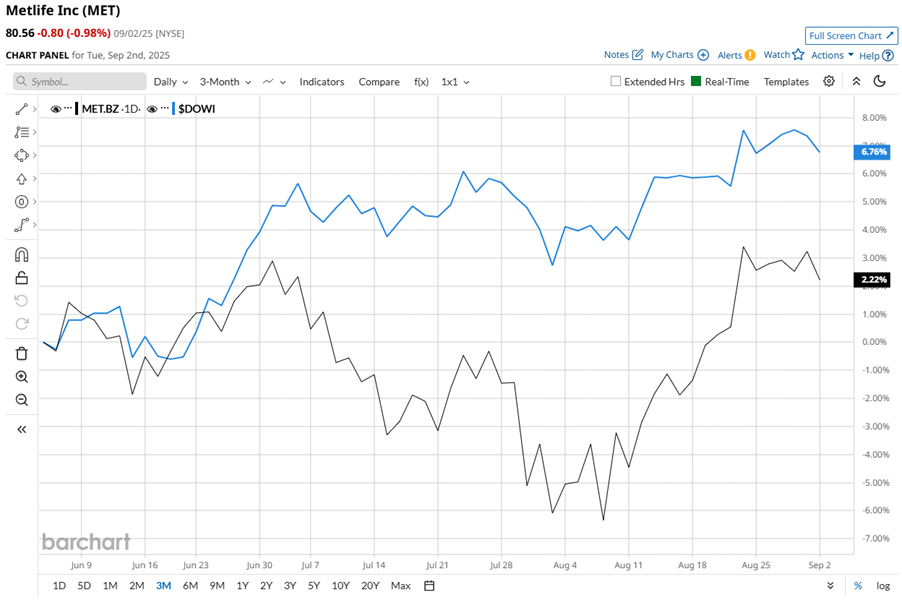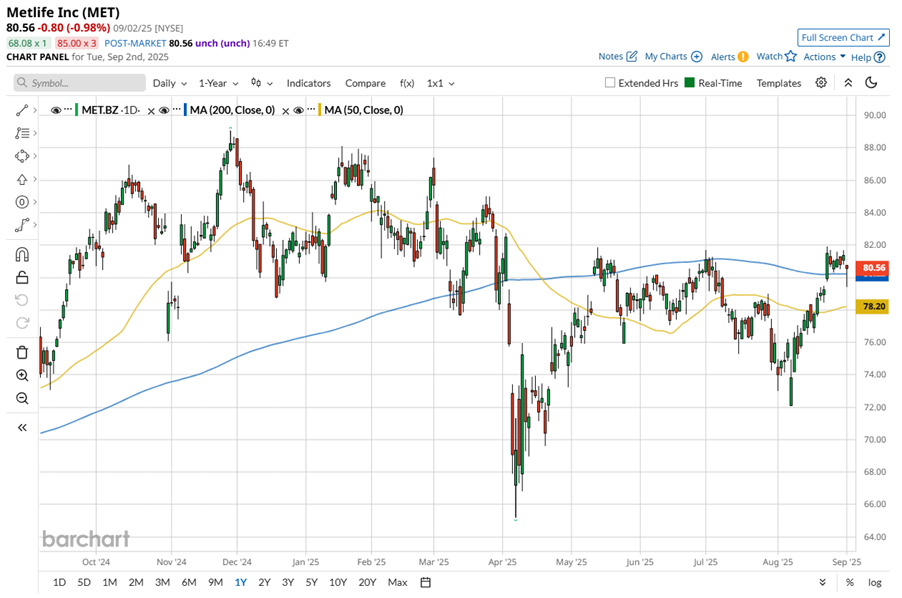- Market Overview
- Futures
- Options
- Custom Charts
- Spread Charts
- Market Heat Maps
- Historical Data
- Stocks
- Real-Time Markets
- Site Register
- Mobile Website
- Trading Calendar
- Futures 101
- Commodity Symbols
- Real-Time Quotes
- CME Resource Center
- Farmer's Almanac
- USDA Reports
Is MetLife Stock Underperforming the Dow?
/Metlife%20Inc%20office-by%20Tupungato%20via%20Shutterstock.jpg)
When thinking of insurance giants, MetLife, Inc. (MET) naturally commands attention. Founded in 1999 and based in New York, the company has built a global footprint, serving millions of customers across more than 60 countries with life, dental, disability, and financial services. Its market capitalization stands at $54.1 billion.
Companies worth $10 billion or more are generally described as "large-cap stocks," and MetLife is firmly positioned in this category, with its market cap exceeding this threshold, signaling both scale and influence in the insurance and financial services industry. Its straightforward business model, consistent returns on equity, and diversified offerings have earned it a solid reputation.
Despite the strengths, the MET’s journey tells a mixed story. Shares of MetLife touched a 52-week high of $89.05 on Nov. 27, but since then, shares have slipped 9.5%. Over the past three months, MET has climbed 2.4%, which is modest - but when comparing that against the Dow Jones Industrial Average’s ($DOWI) 7.1% gains in the same period, the underperformance becomes clear.

The broader trend has not been kinder either – over the past 52 weeks, MET’s 4% return trails the Dow’s 9%, and on a year-to-date (YTD) basis, the stock has declined 1.6% while the Dow has surged by 6.5% in 2025.
MetLife’s momentum looks mixed. The stock spent months below its 200-day moving average since April and even slipped under its 50-day moving average from July, signaling weakness. But since mid-August, MET has staged a rebound, now trading above both key averages. If it sustains this breakout, momentum could shift toward a steadier upside trend.

Fundamentally, though, MetLife remains a strong business. Dividend payouts have been steady, share buybacks continue, and strategic alliances have expanded its reach. Cost-cutting measures and targeted growth strategies have added muscle to its financials. But sentiment has been clouded by some uneven performance. Net derivative losses briefly slowed the rally, despite climbing revenues and surging dividends. Investors have stayed cautious, waiting for clearer signals of sustainable growth.
The insurer’s Q2 2025 earnings report, released on Aug.6, didn’t make things easier. MetLife posted an adjusted EPS of $2.02, missing analysts’ expectations, while adjusted revenue came in at $17.9 billion, falling short of forecasts. Weak underwriting margins in life and non-medical health products caused adjusted premiums, fees, and other revenues to decline 6% year over year (YoY) to $12.7 billion.
However, there was a bright spot. Net investment income rose 9% to $5.7 billion, softening the overall blow. The market’s first reaction was sharp - MET stock slipped 2.8% after the earnings release, but it quickly regained some footing, boosted by dividends. After announcing preferred stock dividends for Q3 on Aug. 15, MET saw five consecutive days of gains, underscoring how shareholder returns are propping up the stock’s short-term strength.
Against competitors, the picture is mixed. Over the past year, MetLife has lagged Sun Life Financial Inc.’s (SLF) 5.8% gains, but in 2025, MET is slightly ahead, as SLF has dipped 2.8% on a YTD basis.
Analysts have been largely bullish on MET’s prospects, though not without a note of caution. The stock carries a “Moderate Buy” consensus from 18 analysts covering it. Meanwhile, Wall Street still sees room for growth. The mean target of $93.07 signals an upside potential of about 15.5% from current levels.
On the date of publication, Sristi Jayaswal did not have (either directly or indirectly) positions in any of the securities mentioned in this article. All information and data in this article is solely for informational purposes. For more information please view the Barchart Disclosure Policy here.